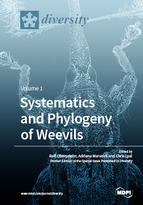Systematics and Phylogeny of Weevils
A special issue of Diversity (ISSN 1424-2818). This special issue belongs to the section "Animal Diversity".
Deadline for manuscript submissions: closed (31 March 2018) | Viewed by 153899
Special Issue Editors
Interests: weevil systematics and phylogeny; evolution and fossil history; biology and host associations; morphology; emphasis on the faunas of Australia and Africa
Interests: phylogenetic systematics of Curculionoidea; larval and adult morphology; molecular markers; evolutionary biology of weevils and other phytophagous beetles
Special Issue Information
Dear Colleagues,
Weevils, beetles of the superfamily Curculionoidea, constitute an extremely diverse branch of the tree of life. About 62,000 species in 5800 genera have been described, but it is estimated that about three times as many exist. The great majority of weevils are phytophagous in both the larval and adult stages, and while their huge diversity is intricately linked to that of the flowering plants (angiosperms), virtually all vascular plants and all plant parts serve as host to one or more species of weevils. Several weevils are serious pests of agriculture and forest industry, whereas others are highly beneficial as biological control agents of weeds or as pollinators of a variety of plants.
Both basic and applied research on weevils is crucially informed by results of systematic and phylogenetic studies, which are fundamental for developing stable and predictive classifications and for posing and testing hypotheses about the evolutionary success of weevils. While recent phylogenetic studies have largely succeeded in reconstructing a robust phylogenetic backbone and stable family-level classification of Curculionoidea, much remains to be done in terms of identifying natural groups and relationships within these families. Further study is also needed in fields such as comparative morphology, biogeography and patterns of host associations.
The forthcoming Special Issue aims to provide an overview of, and new insights into, current hypotheses on weevil systematics, phylogeny, evolution, biogeography, host associations and morphology. We welcome papers presenting meaningful contributions to these and related topics.
This Special Issue also serves as a memorial to Dr. Guillermo (Willy) Kuschel (1918–2017), in recognition of his long and enormous contribution to weevil systematics and phylogeny.
Dr. Rolf Oberprieler
Dr. Adriana Marvaldi
Dr. Chris Lyal
Guest Editors
Manuscript Submission Information
Manuscripts should be submitted online at www.mdpi.com by registering and logging in to this website. Once you are registered, click here to go to the submission form. Manuscripts can be submitted until the deadline. All submissions that pass pre-check are peer-reviewed. Accepted papers will be published continuously in the journal (as soon as accepted) and will be listed together on the special issue website. Research articles, review articles as well as short communications are invited. For planned papers, a title and short abstract (about 100 words) can be sent to the Editorial Office for announcement on this website.
Submitted manuscripts should not have been published previously, nor be under consideration for publication elsewhere (except conference proceedings papers). All manuscripts are thoroughly refereed through a single-blind peer-review process. A guide for authors and other relevant information for submission of manuscripts is available on the Instructions for Authors page. Diversity is an international peer-reviewed open access monthly journal published by MDPI.
Please visit the Instructions for Authors page before submitting a manuscript. The Article Processing Charge (APC) for publication in this open access journal is 2600 CHF (Swiss Francs). Submitted papers should be well formatted and use good English. Authors may use MDPI's English editing service prior to publication or during author revisions.
Keywords
- weevil systematics
- weevil phylogeny (morphological and molecular)
- weevil evolution and fossil history
- weevil biology (plant associations)
- weevil morphology
- weevil biogeography








